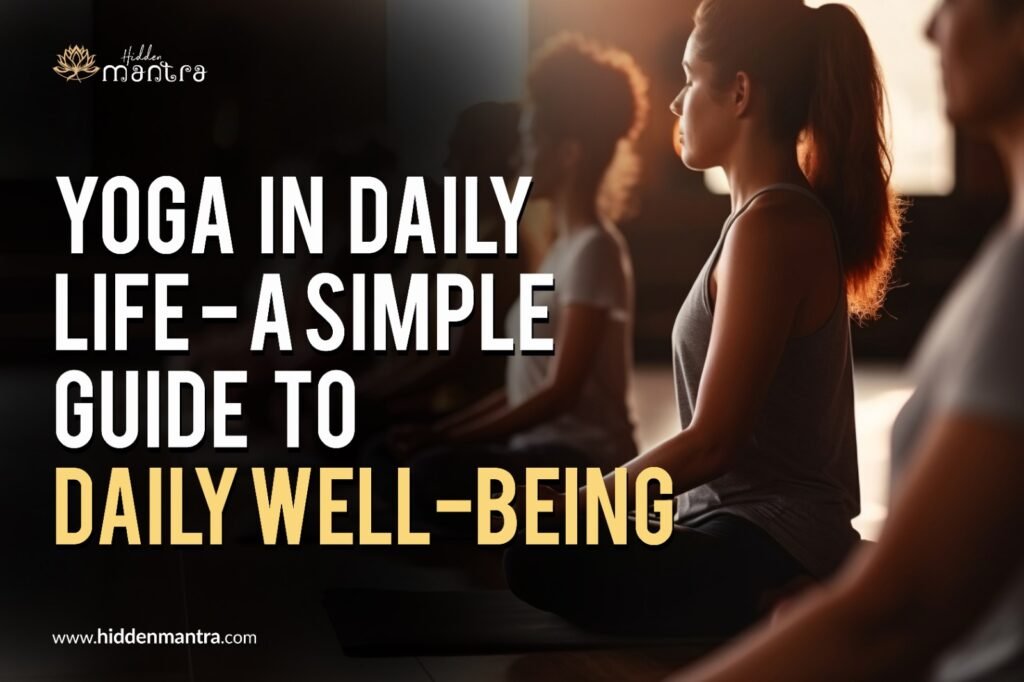Yoga is an art as well as a science that demands a healthy way of living. Yoga in daily life gives you a healthy mind and a healthy body. This mindful practice involves mental, physical, spiritual, and social well-being. When you attain a state of mental health, you can foster good relationships with yourself and with others. The practice of Yoga originated in India; it involves meditation, breathing exercises, stretching poses, and strengthening. Combining body, breath, and senses helps you eliminate stress and focus on calmness and peace to make better decisions and lead a healthy life.
Importance of integrating Yoga into daily life
Yoga in daily life is a healthy practice in a chaotic world that is clouded by stress, tension, and anxiety. So, the importance of Yoga is higher than ever before. For humans, physical health is important, and some of us, the majority of the time, try to focus on the physical aspects of ourselves. In reality, mental health is as crucial as physical health. Every decision in our life is taken by the way we see it; that’s why we always need a focused mind that is devoid of stress and anxiety to approach things more rationally. When you are mentally disturbed, it affects whole aspects of your life. Only a healthy mind can understand the pros and cons of a scenario, so integrating Yoga into daily life is highly beneficial for all of us.
Understanding Yoga in Daily Life
Begin a transformative journey by understanding the essence of yoga in your daily life. Explore the holistic benefits that promote physical well-being, mental health, and a harmonious lifestyle.
What is Yoga in Daily Life?
“Don’t promise when you are happy, don’t reply when you are angry, and don’t decide when you are sad.” – Unknown.
The above quote speaks about the importance of attaining a calm and mentally healthy life. The best way to achieve this is through practising Yoga in daily life. All the people in the world are looking for a peaceful life because everyone, irrespective of their background, goes through various challenges that affect their mental health. Practising Yoga in daily life gives balance and improves your mental health.
Why Yoga in Daily Life?
As we understand the fact that Yoga plays a huge role in helping us lead a peaceful life, it also paves the way to maintaining a healthy relationship with oneself and others. Why we have to embrace the practice of Yoga in daily life is something we must give great thought to.
Yoga in daily life manages your stress and anxiety troubles and helps you get a better sleep. It has the power to restore the autonomic reflex regulatory mechanisms, which help prevent the disablement of cell-mediated immunity.
The health benefits of Yoga in daily life are immense. It plays a huge role in heart health and eases your back pain, joint pain, and arthritis symptoms. Daily practice of Yoga will result in improved energy and greater moods. It gave us an understanding of our body and mind. It helps increase our concentration as well as take part in developing self-awareness.
Importance of Yoga
The word “Yoga’’ is derived from the Sanskrit language, and it means “to unite or “to join.” It implies the idea that Yoga can unite our mind and body. When we can control our bodies as per the direction of a calm mind, then we can achieve everything in our lives. It makes us face the challenges and overcome the struggles. We get a greater understanding of our lives, and we can understand our purpose in life. Yoga is not just an exercise; instead, it is a spiritual path, and it equips us to attain supreme knowledge and ultimately to gain eternal bliss.
10 Types of Yoga Poses for Daily Practice
Transform your life by practising these yoga poses daily. They are designed to enhance strength, flexibility, and inner peace. Dive into the diverse world of yoga for a healthier and more balanced life. Let’s explore each pose in brief, by understanding its benefits and how you can do it for a healthy life.
1. Mountain Pose (Tadasana)
Benefits: It can improve posture and coordination, boost circulation, and improve agility.
How to do it: Perform the Mountain Pose by standing with your feet together, distributing weight evenly. Engage thigh muscles, lengthen the tailbone, and align the spine. Keep arms by your sides, palms forward, and gaze softly ahead. Breathe deeply, balancing evenly on both feet. Maintain the pose for 30 seconds up to one minute.
2. Downward-Facing Dog (Adho Mukha Svanasana)
Benefits: It helps improve digestion, stimulates circulation, and strengthens the shoulder joints.
How to do it: To perform Downward-Facing Dog, start on hands and knees. Lift hips and straighten legs and arms, forming an inverted V shape. Press palms into the ground, relax your head and draw heels towards the floor. Engage the core, lengthen the spine, and breathe deeply. Maintain the pose for 30 seconds up to one minute.
3. Warrior II (Virabhadrasana II)
Benefits: It increases leg strength, opens hips and chest, improves balance, enhances focus, builds stamina, stretches inner thighs, and instils stability and power.
How to do it: To do the Warrior II pose, stand wide with your right foot turned out and your left foot slightly in. Extend arms parallel to the floor, bend right knee over ankle, and look over right hand. Keep the left leg straight, engage the core, and hold for 30 seconds to 1 minute.
4. Tree Pose (Vrikshasana)
Benefits: It improves focus, enhances balance, and strengthens the legs, ankles, and core. This pose also encourages good posture, stretches the thighs, and promotes a sense of grounding and stability.
How to do it: Practice Tree Pose by standing with weight evenly distributed. Shift weight onto left foot and lift right foot, placing sole against inner left thigh or calf. Bring palms together in front of the chest or extend arms overhead. Hold for 30 seconds to a minute. Switch sides.
5. Child’s Pose (Balasana)
Benefits: This pose stretches hips, thighs, and ankles, easing tension and fatigue. It also promotes mental relaxation, reduces stress, and aids digestion.
How to do it: To practice Child’s Pose (Balasana), start in a tabletop position. Sit back on your heels, knees hip-width apart. Extend arms forward, lower chest to floor, rest forehead on the mat. Breathe deeply and hold for a calming experience.
6. Cat-Cow Pose (Marjaryasana-Bitilasana)
Benefits: This pose improves flexibility and strength in the spine, shoulders, and neck. It also enhances coordination between breath and movement, massages the abdominal organs, and helps relieve back pain.
How to do it: Practice Cat-Cow Pose by starting in a tabletop position. Inhale and arch your back for Cow Pose, lifting your tailbone and head. Breathe out as you round your spine in a Cat Pose. Repeat for 1-2 minutes.
7. Cobra Pose (Bhujangasana)
Benefits: The backbend pose strengthens the spine, opens the chest, and enhances shoulder and abdominal flexibility. It also stimulates abdominal organs, improves digestion, and offers relief from stress and fatigue.
How to do it: To do Cobra Pose, lie on your stomach with your legs extended and feet on the mat. Place hands under shoulders, and lift the chest off the mat while keeping elbows slightly bent. Hold for 15-30 seconds, focusing on deep breaths.
8. Seated Forward Bend (Paschimottanasana)
Benefits: The Seated Forward Bend pose stimulates abdominal organs, aiding digestion and calming the nervous system. Regular practice improves posture, relieves stress, and reduces anxiety.
How to do it: To practice Seated Forward Bend, sit with your legs extended in front of you. Inhale, lengthen the spine, exhale, and hinge at the hips, reaching forward. Hold onto shins, ankles, or feet, keeping back straight. Maintain the pose for 30 seconds up to one minute.
9. Corpse Pose (Savasana)
Benefits: Savasana promotes relaxation, integration, and unwinding of the body and mind. It reduces stress, calms the nervous system, and improves overall well-being.How to do it: To practice Corpse Pose (Savasana), lie on your back with your legs extended and arms by your sides. Let your feet naturally open and gently close your eyes. Focus on breathing and release tension from the body. Stay for 5-15 minutes.
10. Bridge Pose (Setu Bandhasana)
Benefits: This pose strengthens the legs, glutes, and lower back, opens the chest, and improves spine flexibility. It stimulates abdominal organs, aids digestion, and alleviates stress and mild depression.How to do it: To do the Bridge Pose, lie on your back with knees bent and feet hip-width apart. Lift hips, engage glutes and thighs, and hold for 30 seconds to a minute. Lower back down.
Why is Yoga Important in Modern Life?
In modern life, most of us are in a struggle with our mental health. We give prime importance to material well-being and fail to take care of our mental health. So, in this modern era, it is highly important to practice Yoga in daily life to avoid stress, tension, and anxiety and lead a peaceful and calm life. Practice those mentioned above ten daily yoga poses and guide yourself to a life that is devoid of stress and abundant in peace and calmness. Discover more about Yoga and its positive effect on life by exploring the yoga blog section. To learn more about peaceful practices, visit Hiddenmantra. Your path to a calm and serene well-being starts here.









